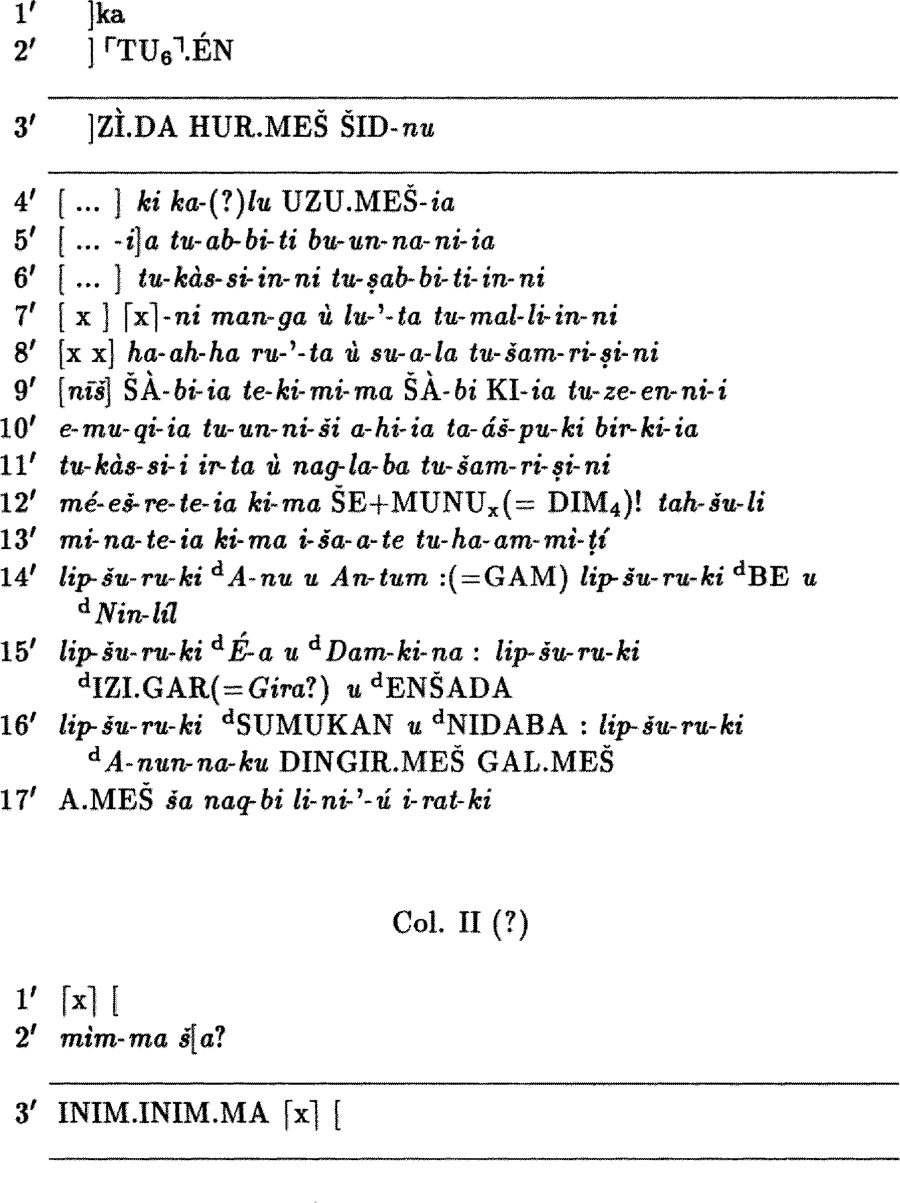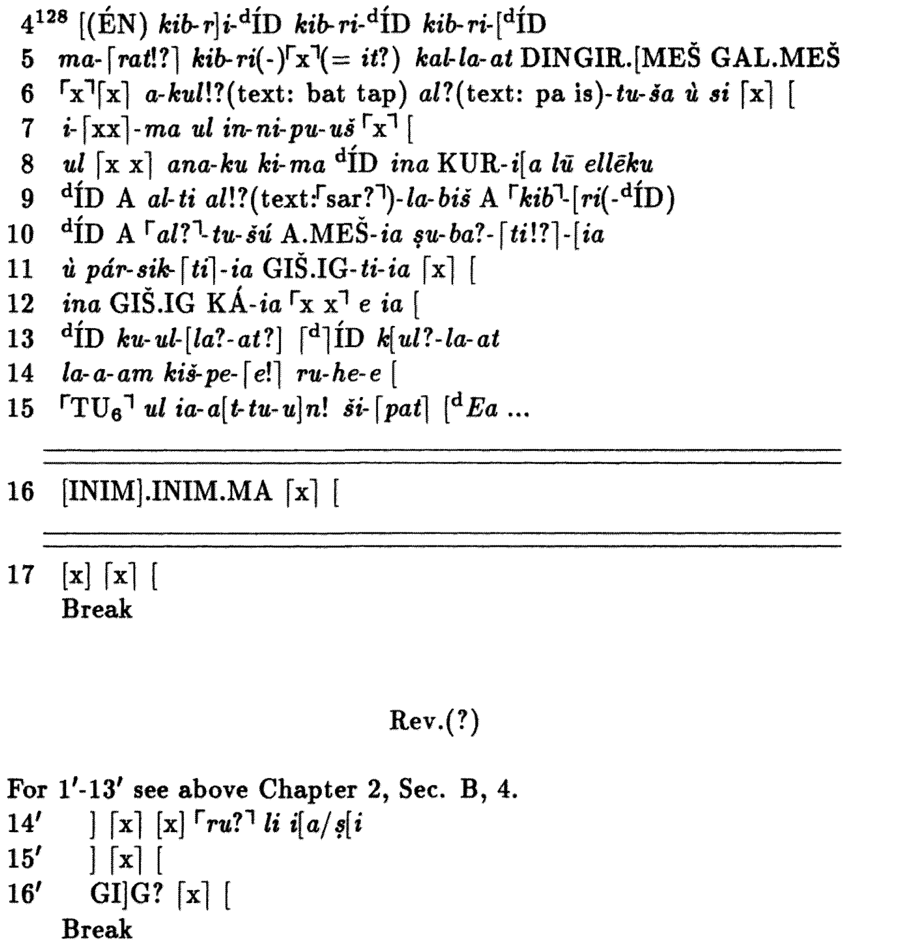- Excursus
- Chapter
- Brown Judaic Studies
- pp. 77-82
-
- View Citation
- Additional Information
Excursus
We are presently unable to determine whether KAR 269 is a collection of incantations and rituals or a consecutive complex ritual, though we tend to think the latter more probable. In either case, it is closely related to Maqlû:
(1) Obv.(?) I 5′ (Ebeling’s 4)-12′ is a parallel of M V 1-10. Note the absence of M V 4-5.120
(2) Obv.(?) II 1-3 = M VII 144-147.121
(3) Obv.(?) II 4-15 is related to the incantations in Maqlû which center on kibrītu. Cf. M VI 73-110 and compare especially obv. II 4 with M VI 78; obv. II 5 with M VI 73 (AN-e should probably be emended to DINGIR.MEŠ), 109 and Sm 352 rev. 16′ obv. II 6, 9 and 10 with M VI105; obv. II 7 with M VI 80; obv. II 8 with M III 77, 88 and Tallqvist, Maqlû, II p. 96: K 8112 left col. 5: [u anaku kīma dÍD ina KUR-i’]a lu el-le-ku.
(4) Rev.(?) 1′-12′ is the parallel of M VII 119ff. discussed above.
One should study this Assur text in conjunction with KAR 226, part of which was edited above (Chapter 1). It is tempting to assume, though this remains completely uncertain, that these two texts form part of one sequence.122
We present below transliterations of these two tablets omitting those parts which have already been edited in the text of our study.
KAR 226
Col. I (?)
4′123 ÉN MÍ.UŠ12 bu[r-ta-ni-tu ... ]
5′ a-šip-tu i[š-še-bu-tu ... ]
6′ qa-diš-tu na-[di-tu ... ]
7′ ṣa-a-a-di-tu ša [ ... ]
8′ mu-la-ib-tu ša A[N-e ... ]
9′ ka-si-i-tu ša pi-i [ ... ]
10′ da-ik-tu ša GURUŠ.M[EŠ ... ]
11′ ša-hi-ṭa-te e ša ṣab-[bu-ri-tu
12′ mu-ut-tal-lik-tu [ ... ]
13′ ša a-na kiš-pi-ša ru-he-e-⌈ša⌉ [ ... ]
14′ e-nin-na a-na-ku a-ṭa-ma[r?(-ki) ... ]
15′ uš-te-pi-lu-ki uš-ta-b[al?-kit(u)(-ki) ... ]123
Cot III (?)
1 lu-ù ku-ri ŠÀ-ba-ša ⌈x⌉ [ ... ]
2 lik-ru ŠÀ-ba-sa ka-bat-ṭa-[sa ... ]
3124 ki-ma kib-ru a-na k[ib!?-ri la iqerri/ubu ... ]
4 ep-šu-ša up-sa-su-[ša lemnūti... (lā iṭehhûni))
5 la-a i-ger-[ri/ru-bu-ni jâši ... ]124
6 ⌜muš⌝ ⌈x⌉ [
Break
Col. IV (?)
1 INIM.INIM.MA ⌈x⌉ [ ... ] ⌈x⌉ šul?
2 ÉN 3-šú ŠID-nu [ ... ]
For 3fF. see above Chapter 1 and note 2.
KAR 269
Obv.(?) Left Col.125
1′ ]⌈x⌉
2′ ] ÍL-ma
3′ ] ta-hap-pi
4′ ] ⌜ti⌝/⌜an⌝
5′ [(...) ēpišti u] mul-te-piš-ti
6′ [ ... ] ep-še-te-ia
7′ [īpušā (...) bunnannīya] ú-mas-ši-lu
8′ [ ... ṣalmīya i-ban]-na mi-na-[ti!?] (text: ⌈ki?⌉)-⌜ia⌝
9′ [ubbirū (...) ipšī/epšēti tēpušā lū ša]at! (text: it)-tu-ki-na
10′ [ ... mê tahbî lū] [ša] ra-ma-ni-ki-na
11′ [šipatkina aj iqriba INIM.MEŠ-ki]-na!? (text: ba?) a-ia ik-šu-da-ni
12′ [ ... ] šu”! ba la hi126
13′ ] ⌈x⌉ uš na ⌈x⌉ ka-a-ša
14′ ] [su?] ⌈x x⌉ [x x k]a! mi
15′ ] mi
16′ ] mi
17′ ] ⌜hu⌝/⌜ri⌝
Break
1 [dAMAR.UD ia-a-š]i ru-[ṣa-nim-ma lip-pa-ás-ru kiš-pu]
2 [ru-hu]-ú ⌜ru⌝-su-ú u[p-šá-šu-ú lemnūti ša amēlūti]
3 [ù] ma-mi-tú ša SU-ia [ ... ]127
Notes
120Exegetical considerations seem to favor the originality of the absence.
121See above note 56 and below note 127.
122The frequent use of double dividing lines in KAR 269 seems to preclude the possibility that the two texts are from the same tablet.
123 For 4-15′ cf. M III 31ff. (the two texts were already associated by Meier, Maqlû, p. 23, nn. 7-8 and .A/0 21 74). Our restorations and textual notes are not intended to be exhaustive, and the reader is referred to M III 31ff. Notes to KAR 226 II 4′ff.
7′: The Maqlû MS STT 82:46-47 has ha-a-a-ṭi-turn.
9′: This text probably agrees with the Maqlû MS STT 82:50-51 (ka-si-tum šá KA diš-tar. MEŠ) against the other MSS.
11′: Compare M III 54. what is e ša?
12′: Absent in Maqlû.
13′: M III 55 has ip-ši-šá instead of kiš-pi-šá.
14′-15′: Compare M III 56-58, and note especially the variants provided by STT 82. M III 56-58 seems to have undergone corruption. We may note two possibilities of interpreting these lines. While it is more than possible that neither interpretation is correct, we are very attracted by the second.
(1) On the assumption that the verbs in M III 56-58 are first person verbs and on the analogy of 58, could the direct object of the verbs in 56f. originally have been terms for witchcraft? If so, read, e.g., ki(ipiki) (abbreviation; cf., M IV 17ff., for which see AfO 21 76)/<kišpī> ki (haplography).
(2) Could the verbs in 56-58 originally have been third person verbs whose subject is witchcraft and whose object is the witch? This suggestion is supported by the -u suffix of the verbs and by the i- prefix documented for those in 56-57a (the other verbs have the ambiguous - prefix): i-TAM-ru-ki iṣ-ṣab-tu-ki i-te-ni-u-ki (STT 82). If this suggestion is correct, we should read i-tú-ru-ki (târu), rather than i-tam-ru-ki (accordingly, KAR 226-if correctly restored-is a hypercorrection), and we should compare i-tú-ru-ki iṣ-ṣab-tu-ki (56) to, e.g., li-tir-ru-ma li-is-ba-tu-ki ka-a-ši (M VII 160) and ú-tar-ru kiš-pi-ki ru-hi-ki ú-ṣa-ab-ba-tu-ki ka-a-ši (M VII 169).
124This motif and related ones are also found elsewhere in the witchcraft corpus. They appear either in the form (as here): “just as Xt cannot approach X2, so too may witchcraft not approach me” (cf. M VI 64-68), or in the more common form “just as witchcraft cannot approach Y, so may it not approach me” (cf., e.g., M VII 54-57 and 182-185). A motif similar to that found in our text appears outside the witchcraft corpus, for example, in JNES 15 136:96f. (note that irger-[r]u there should almost certainly be emended to i-qer-[r]u-<bu>, since the simile as presently constituted is simply untrue and since gerebu is frequently used elsewhere in similar contexts).
125Our line count in this column is one higher than that of the copy.
126Restorations are uncertain and are presented simply to indicate the similarities between this incantation and M V Iff. For further possible restorations of several of the lines, see that text. It is possible that line 12′ should be read: a-a iq]-⌈ri⌉-ba <a-ia> TEf-M.
127The reading of this line is difficult, because littaṣi is consistently found between māmīt and ša zumriya in the other occurrences of this line (Šurpu V-VI 196; M VII 146). Since there seems to be space for approximately six to seven signs in the break at the end of KAR 269 obv. II 3, it is difficult to simply read: [ù] ma-mi-tu ša SU-ša [lit-ta-ṣi] or [ù] ma-mi-tu <lit-ta-ṣi> ša SU-ia [ ... ]. Perhaps we should read: [u] ma-mi-tu <<ša SU-ia>> [lit-ta-ṣi ša SU-ša].
128Emendations and restorations are tentative.







